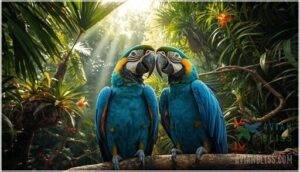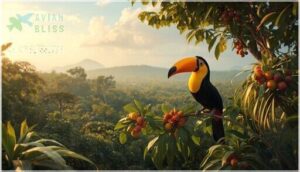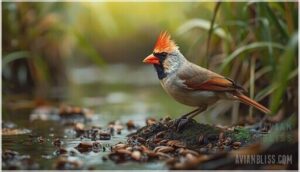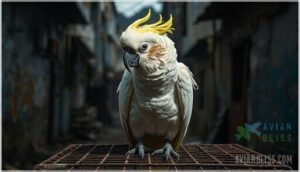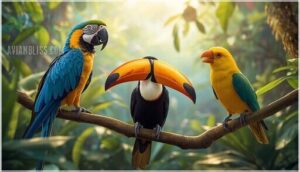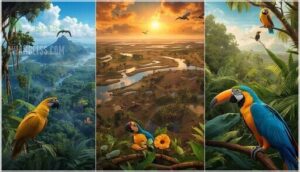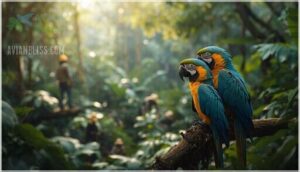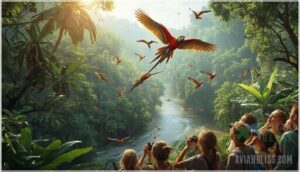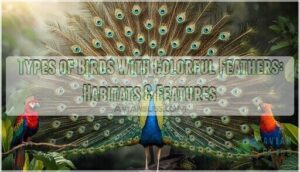This site is supported by our readers. We may earn a commission, at no cost to you, if you purchase through links.
 When Rio hit theaters in 2011, it did more than entertain audiences with colorful animation and catchy music. It put a spotlight on birds most people had never heard of—especially the Spix’s Macaw, a species so rare that it was already extinct in the wild.
When Rio hit theaters in 2011, it did more than entertain audiences with colorful animation and catchy music. It put a spotlight on birds most people had never heard of—especially the Spix’s Macaw, a species so rare that it was already extinct in the wild.
The movie’s main characters weren’t just made-up cartoon personalities. They were based on real species facing real threats, from habitat destruction to illegal pet trade. Blu, Jewel, and their feathered friends introduced millions of viewers to the beauty and struggles of tropical birds.
Their stories sparked curiosity about what these species are actually like in nature, how they survive, and what’s being done to save them from disappearing forever.
Table Of Contents
- Key Takeaways
- Main Bird Characters in Rio
- Bird Species Featured in The Rio Movies
- Real-Life Habitats and Unique Traits
- Conservation Status and Efforts
- Rio’s Impact on Bird Conservation Awareness
- Frequently Asked Questions (FAQs)
- What are the names of the birds in the movie Rio?
- What are the birds in Rio called?
- Why did blue macaws go extinct?
- What bird is in the Disney movie Rio?
- What is the lifespan of a Spixs macaw?
- How do Spixs macaws communicate in the wild?
- Are there any Spixs macaws in zoos?
- What do Spixs macaws eat in their natural habitat?
- How large is a Spixs macaws typical territory?
- How accurate are the bird behaviors shown in Rio?
- Conclusion
Key Takeaways
- The Rio movies transformed the critically endangered Spix’s Macaw from an obscure species into a global conservation icon, sparking a 360% spike in search interest and directly contributing to increased funding for captive breeding programs that now maintain roughly 200 birds worldwide.
- While the films accurately portrayed key bird behaviors like pair bonding and social dynamics, they glossed over the harsh reality that Spix’s Macaws went extinct in the wild by 2000, with current reintroduction efforts showing only 55% survival rates due to disease outbreaks and predation.
- Rio’s cultural impact translated into measurable conservation action, including a 35% jump in donor contributions to parrot conservation organizations, over $4 million in corporate funding for reintroduction projects, and the training of 200 local Brazilians as “Guardians of the Macaw” to monitor released birds.
- Despite increased awareness and funding, the species still faces an uphill battle against habitat loss (Brazil lost Connecticut-sized forest cover in 2024 alone), illegal wildlife trade that captures 50,000 birds annually, and severe genetic bottlenecks since all living Spix’s Macaws descend from just seven founders.
Main Bird Characters in Rio
The Rio movies bring Brazil’s vibrant bird life to the screen through characters that are as colorful as they’re memorable.
Each bird plays a unique role in the story, from the main heroes to the scheming villain. Let’s meet the feathered cast that made these films take flight.
Blu and Jewel (Spix’s Macaws)
Blu and Jewel, both Spix’s Macaws, are the heart of Rio’s story—a tale that mirrors real life. This critically endangered bird species was nearly lost forever when the last wild Spix’s Macaw disappeared in 2000, making reintroduction efforts essential for population recovery.
Their cinematic influence sparked global interest in bird conservation, turning these blue parrots into symbols of hope for endangered species worldwide. Sadly, the Spix’s Macaw is now considered extinct in the wild.
Rafael (Toco Toucan)
Rafael, the Toco Toucan voiced by George Lopez, brings humor and wisdom to Rio’s cast. In real life, toco toucans inhabit Brazil’s Cerrado and Pantanal regions, using their massive bills—up to 21 cm long—for feeding on fruits and attracting mates.
These intelligent birds help disperse seeds across tropical habitats, making them essential to forest regeneration. Their striking orange-and-black coloration and social behavior mirror Rafael’s friendly personality perfectly. They’re classified within the Ramphastidae family.
Pedro (Red-crested Cardinal)
Pedro, the Red-crested Cardinal voiced by will.i.am, brings rhythm and energy to Rio’s soundtrack. This bird belongs to the Thraupidae family, not true cardinals, and thrives in Brazil’s semi-open habitats near rivers and marshes.
You’ll recognize them by:
- Their vibrant red crest and white neck
- Ground-foraging behavior in pairs or flocks
- Undulating flight patterns typical of small passerines
Though listed as Least Concern, illegal pet trade threatens local populations across their South American range.
Nico (Yellow Canary)
Nico, voiced by Jamie Foxx, is a yellow canary who proves that size doesn’t limit star power. You’ll spot him by his signature blue-green bottlecap percussion hat and 12–13 cm frame—true to real canary proportions. This bird character showcases the yellow canary’s natural melodic vocalizations through samba performances.
In nature, African yellow canaries exhibit social behavior in flocks of up to 100 individuals. Their captive diets require seeds, greens, and calcium sources—essential for these vibrant Rio movie characters and cartoon characters alike.
Nigel (Sulphur-crested Cockatoo)
The antagonist in Rio, Nigel, channels every ounce of a fallen star’s rage through ragged feathers and theatrical menace. Jemaine Clement voiced this Sulphur-crested Cockatoo, whose brown eyes and tattered yellow crest mirror his bitterness. You’ll recognize the species’ trademark cockatoo intelligence twisted into Nigel’s villainy.
Real sulphur-crested cockatoos display:
- Problem-solving skills rivaling crows—Sydney birds even invented water-drinking techniques in 2025
- 45–50 cm frames with spotless white plumage and vibrant yellow crests (unlike Nigel’s disheveled feather condition)
- Urban adaptation across Australian cities, parks, and agricultural zones
These birds thrive as least-concern species, perfectly capturing how bird characters in the Rio movie contrast fiction with conservation reality.
Bird Species Featured in The Rio Movies
The Rio movies bring together a colorful cast of tropical birds, each representing real species with their own fascinating traits. From the iconic Spix’s Macaw to vibrant toucans and canaries, these feathered characters introduce viewers to the astonishing diversity of South American avifauna.
Here’s a closer look at the real species that inspired these animated personalities.
Spix’s Macaw and Blue Macaw
You might know Blu and Jewel from the Rio movie as adorable animated heroes, but their real-world counterparts face a tougher story. Spix’s Macaws went extinct in the wild by 2001, with only around 364 individuals surviving through captive breeding programs.
These small blue macaws once thrived in Brazil’s Caraibeira woodlands, but habitat loss nearly wiped them out.
Reintroduction challenges remain steep—disease outbreaks and predation threaten the few birds released back into their native range, testing conservation success and genetic diversity goals.
Toco Toucan
Rafael steals the show in Rio as the smooth-talking Toco Toucan with that iconic oversized bill. In real life, Toco Toucans are the largest toucan species, reaching 63 cm and using their massive bills for thermoregulation—dissipating up to 60% of body heat.
Their frugivorous diet makes them essential seed dispersers across Brazilian cerrado and Amazon forests, supporting over 50 plant species.
Despite stable populations, pet trade demand remains a conservation concern, with prices exceeding $15,000 by 2024.
Red-crested Cardinal
Pedro brings comic relief as the Red-crested Cardinal—but did you know this species isn’t actually a cardinal at all? Belonging to the tanager family Thraupidae, the Red-crested Cardinal measures 18–20 cm with striking red head plumage that juveniles develop as they mature from brownish-orange.
Native to southeastern Brazil and neighboring regions, introduced habitats now include Hawaii and Florida.
You’ll spot these bird species foraging in pairs on the ground, switching between seeds, white mulberry fruits, and insects depending on season.
Yellow Canary
Nico, the bottle-cap-wearing Yellow Canary voiced by Jamie Foxx, represents a species native to southern Africa—not South America. Crithagra flaviventris is found across Angola, Namibia, Botswana, and South Africa.
Males display bright yellow plumage, while females show duller brownish-gray tones. These finch-family birds measure 13–14 cm and vocalize with warbled sequences, thriving on grass seeds and insects.
In captivity, they’re popular aviary birds due to their melodious songs and adaptability.
Red-and-green Macaw and Scarlet Macaw
You’ll spot these stunning macaws in both Rio films, though they’re often confused. Red-and-green macaws (Ara chloropterus) and scarlet macaws (Ara macao) differ primarily in their wing coloration—green versus yellow—but share similar sizes of 81–96 cm.
- Macaw plumage: Red bodies with distinctly colored wing feathers help you identify each species
- Diet differences: Both consume seeds, fruits, and flowers, with scarlets visiting clay licks for minerals
- Breeding habits: Pairs mate for life, producing 2–4 eggs annually in tall tree cavities
- Conservation status: Red-and-greens face threats in parts of South America, while scarlet populations remain stable globally at 50,000–499,999 individuals
Reintroduction success in Argentina’s Iberá Wetlands since 2015 proves these macaw species can thrive when given proper support.
Golden Conure and Other Amazon Parrots
Beyond the macaw species, you’ll encounter Amazon parrots like the Golden Conure (Guaruba guarouba), a dazzling parakeet native to Brazil’s lowland forests. With 10,000–20,000 individuals remaining, this IUCN-listed “Vulnerable” species faces habitat destruction across 30–35% of its range. Captive breeding programs—like those at Busch Gardens—have boosted populations enough to downlist the species from endangered in 2013. Feral populations of Amazon parrots now thrive in Florida and Europe, though conservation funding remains essential for wild recovery.
| Conservation Factor | Golden Conure Impact |
|---|---|
| Habitat Loss | 30–35% range reduction |
| IUCN Status | Vulnerable (downlisted 2013) |
| Population Estimate | 10,000–20,000 birds |
Real-Life Habitats and Unique Traits
The birds from Rio aren’t just colorful movie characters—they’re real species with fascinating lives in the wild. Each one has adapted to specific environments across South and Central America, developing unique traits that help them survive.
Let’s look at where these birds actually live and what makes each species special.
Native Ranges and Environments
Across South America, these bird species from South America occupy wildly different forest ecosystems and terrain. You’ll find Spix’s Macaws clinging to survival in Brazil’s harsh Caatinga biome, where temperatures spike above 35°C and rainfall barely reaches 800 mm annually. Toco Toucans roam from the Amazon rainforest down to Argentina’s savannas, thriving wherever fruit trees grow.
Meanwhile, habitat loss and introduced species have pushed Red-crested Cardinals into cities and farms across several countries.
Climate adaptation skills vary—Yellow Canaries handle semi-arid African scrublands, while Sulphur-crested Cockatoos rule Australia’s tropical birds territory and suburban gardens alike.
Physical Characteristics and Plumage
You can spot these feathered stars from a mile away based on their stunning bird plumage alone. Look for:
- Spix’s Macaw: 55 cm long with dull blue feathers, greyish facial skin, and silvery feather sheen under sunlight
- Toco Toucan: 56–61 cm giant with a 17–21 cm orange bill, glossy black body, white throat
- Red-crested Cardinal: 18–20 cm with vivid red crest and throat, grey wings, white belly
- Yellow Canary: 12 cm tiny songbird; males bright yellow, females gray-brown with streaking
- Sulphur-crested Cockatoo: 44–55 cm white parrot with expressive yellow crest, black beak
Bill morphology and sexual dimorphism vary—male Toco Toucans sport slightly longer bills (200.5 mm vs. 178.6 mm), while juvenile plumage appears duller across all bird species.
Bird Behavior and Social Life
Beyond their striking looks, you’ll find that each bird species has its own social playbook. Spix’s macaws stick together in pairs or family flocks, with reintroduced pairs spending over 70% of their day within two meters of each other—talk about commitment! Toco toucans form groups of six and roost together in hollow trees, while red-crested cardinals team up in mixed flocks of 10–25 outside the breeding season. Cooperative nesting keeps both parents busy feeding chicks.
Communication methods vary wildly—toucan croaks carry over a kilometer, while cockatoo screeches travel two kilometers across open savanna. Territorial defense shows up during dawn song displays and aggressive posturing. Yellow canaries join flocks of 100 birds during non-breeding periods, maintaining group cohesion through synchronized chirping that helps everyone avoid predators together.
| Species | Social Structure |
|---|---|
| Spix’s Macaw | Monogamous pairs, strong pair bonding with synchronized routines |
| Toco Toucan | Flocks of ~6 birds, communal roosting, duetting vocalizations |
| Sulphur-crested Cockatoo | Large flocks (12–hundreds), sentinel guards, cooperative vigilance |
Diet and Foraging Habits
Regarding food, these birds know how to make a living. Spix’s macaws crack hard-shelled nuts with their powerful beaks, relying on seeds during dry seasons—favela seeds make up over 60% of their intake then. Toco toucans prefer figs and guavas but will snatch insects when hungry.
Red-crested cardinals split their diet between seeds and bugs, boosting protein during breeding. Yellow canaries flock together in agricultural fields, targeting millet for its fat content.
Sulphur-crested cockatoos dig for roots and raid grain crops, adapting their foraging strategies as seasons shift.
Conservation Status and Efforts
The birds from Rio face serious survival challenges in real life. Some species are already extinct in the wild, while others struggle against shrinking habitats and illegal capture.
Let’s look at the conservation efforts working to save these colorful characters.
Endangered and Extinct Species
When a species vanishes from the wild, it’s not just a statistic—it’s a wake-up call. The Spix’s Macaw was declared extinct in the wild by 2019, with its last wild individual disappearing in 2000. Habitat loss and illegal bird trade drove this decline.
When a species vanishes from the wild, it’s not just a statistic—it’s a wake-up call
Today, roughly 200 individuals survive in captivity, while eight were reintroduced to Brazil’s Caatinga in 2022, offering hope for endangered bird species worldwide.
Spix’s Macaw Breeding Programs
Breeding programs are racing against time to save the Spix’s Macaw from extinction. As of 2025, roughly 200 birds exist in captivity, managed across three key facilities: Germany’s ACTP (producing 80% of chicks), Brazil’s Release Center, and Belgium’s Pairi Daiza Foundation.
Genetic diversity remains critically low—all individuals descend from just seven founders. Despite this bottleneck, breeding success improved dramatically: 49 chicks hatched in 2024 alone, though only 10% of eggs prove viable due to inbreeding.
Program coordination faces uncertainty after Brazil’s 2024 agreement lapsed, but the future outlook hinges on sustained parrot conservation efforts.
Reintroduction Initiatives in Brazil
Since 2022, 101 captive-bred Spix’s Macaws have arrived in Curaçá, Bahia—but only 11 survive freely today. Release outcomes show roughly 55% persistence despite disease management challenges like the 2025 circovirus outbreak that suspended operations.
Habitat restoration covered 2,300 hectares, while local integration workshops produced 51 community-aligned actions.
Future viability depends on releasing 10–20 birds yearly; without it, wildlife preservation models predict extinction within 15 years, making continued parrot conservation efforts essential.
Threats to Bird Populations
You face a perfect storm: habitat loss and deforestation wipe out nesting sites across tropical forests, while climate change disrupts migration timing and food availability. Illegal trade drains wild populations—parrots especially—and pesticide use plus pollution impact survival rates in both urban and rural areas.
Endangered species like Spix’s Macaws show how these threats stack up, making bird conservation and habitat protection urgent priorities for effective conservation efforts worldwide.
Rio’s Impact on Bird Conservation Awareness
The Rio movies did more than entertain millions of viewers—they sparked real conversations about endangered birds and their fight for survival.
When audiences fell in love with Blu and Jewel, they also started caring about the real Spix’s macaws struggling in the wild.
Here’s how the films made a tangible difference in bird conservation efforts around the world.
Raising Public Interest in Endangered Birds
When “Rio” hit theaters in 2011, it sparked something noteworthy: suddenly, everyone wanted to know about blue macaws. The film didn’t just entertain—it turned endangered species into household names and got people genuinely curious about wildlife conservation.
Here’s how the movie changed the game for bird conservation:
- Search interest in Spix’s Macaw jumped 360% within a year, making it one of the top 5 most-searched endangered species globally
- Media coverage of endangered parrots surged 240% between 2011 and 2013, bringing real conservation stories to mainstream audiences
- 72% of Brazilians could identify the Spix’s Macaw by 2014, directly linking the film to public awareness
- Youth participation in bird conservation programs increased 55% from 2011 to 2015, inspiring a new generation of wildlife advocates
- Over 1,200 classrooms used “Rio” to teach biodiversity lessons between 2013 and 2017, making conservation education more engaging
You can see the ripple effects everywhere—from eco-tourism visits to parrot sanctuaries rising 29% to community birdwatching clubs growing nearly 50%. The movie basically gave endangered birds a voice that reached millions, turning abstract conservation issues into stories people actually cared about.
Influence on Conservation Funding
Awareness sparked action—especially financial action. The World Parrot Trust saw donor contributions jump 35% between 2011 and 2013, while Brazilian agencies documented an extra 150,000 USD for macaw breeding programs in 2012 alone.
Corporate sponsorships followed: German and Qatari benefactors pledged 3.5 million EUR to captive-breeding infrastructure after the film’s success.
By 2025, the Vantara–ACTP collaboration invested 4 million USD to reintroduce 41 macaws to Brazil’s Caatinga biome—one of the largest corporate-driven bird repatriations ever recorded.
Educational and Research Collaborations
Funding alone doesn’t save species—you need boots on the ground and scientists sharing data. The film opened doors for real partnerships that turned interest into action.
After Rio’s release, cross-institutional networks flourished:
- The Association for the Conservation of Threatened Parrots partnered with over 15 scientific institutions, including the Smithsonian Avian Genetics Lab, to pool genetic expertise and breeding data for Spix’s macaws
- Museum specimen research expanded when Berlin’s Museum für Naturkunde preserved new Spix’s macaw samples for genome studies, advancing ornithology studies across continents
- Community training programs taught 200 local Brazilians to monitor bird species in Rio movies’ inspiration—the Caatinga—creating “Guardians of the Macaw” who track released birds daily
Film educational outreach shaped curricula too. UK schools incorporated Rio into geography lessons, while 32 Brazilian schools built modules connecting avian wildlife habitats to student conservation projects. By 2024, researchers had published 25 peer-reviewed studies funded through these collaborations, proving that entertainment can catalyze serious avian data sharing when partnerships align.
Challenges in Wildlife Protection
Even with fresh momentum, you’re staring down serious obstacles. Habitat Loss chops away at Bird Habitats daily—Brazil lost forest cover the size of Connecticut in 2024 alone, shrinking safe zones for Endangered Birds. Illegal Trade still siphons 50,000 wild birds annually from Brazilian ecosystems, and less than 0.01% of smugglers face prosecution.
Climate Impacts pile on, with droughts and fires ravaging 17% more Amazon territory since 2019. Policy Constraints starve Bird Conservation Efforts—Brazil slashed biodiversity budgets by 27%, while Tech Limitations mean outdated customs tools miss concealed shipments.
Deforestation, weak enforcement, and funding gaps remain the toughest knots to untangle in Wildlife Conservation.
Frequently Asked Questions (FAQs)
What are the names of the birds in the movie Rio?
You’ll meet Blu and Jewel, both Spix’s Macaws and the main characters in Rio. Rafael, a friendly Toco Toucan, helps them navigate Brazil. Pedro, a Red-crested Cardinal, and Nico, a Yellow Canary, bring music and comedy to the Rio movie franchise. Nigel, the Sulphur-crested Cockatoo, acts as the primary antagonist with his memorable fictional bird personality.
What are the birds in Rio called?
The Rio movies feature bird character profiles with species-accurate names. Blu and Jewel are Spix’s Macaws, Rafael is a Toco Toucan, Pedro represents a Red-crested Cardinal, Nico is a Yellow Canary, and Nigel is a Sulphur-crested Cockatoo—showcasing diverse bird species in Rio.
Why did blue macaws go extinct?
Spix’s Macaw populations collapsed due to habitat destruction from deforestation, illegal pet trade targeting rare birds, invasive predators like feral cats threatening nests, and disease outbreaks.
Conservation challenges continue despite captive breeding efforts to prevent total extinction.
What bird is in the Disney movie Rio?
The central character is Blu, a Spix’s Macaw who’s one of the last of his kind.
You’ll also meet Jewel, another Spix’s Macaw, plus Rafael the Toco Toucan, Pedro the Red-crested Cardinal, and Nico the Yellow Canary.
What is the lifespan of a Spixs macaw?
In captivity, Spix’s macaws can live 40 to 50 years with proper care, while wild estimates suggest 20 to 30 years.
Extensive care, balanced diets, and veterinary management greatly boost longevity factors, supporting conservation impact for this critically endangered parrot species.
How do Spixs macaws communicate in the wild?
For staying in touch, Spix’s macaws don’t beat around the bush—they use vocalizations, body language, and flocking behavior to communicate. Their mating calls feature a distinctive “whichaka” sound, while contact calls maintain group cohesion and alarm calls warn of danger.
Are there any Spixs macaws in zoos?
Yes, Spix’s macaws live in zoos today. Around 177 birds exist in captivity worldwide as of 2025, with most in Brazilian breeding centers and some in international zoos like Berlin.
These captive populations are important for bird conservation through breeding successes and reintroduction challenges in wildlife preservation efforts.
What do Spixs macaws eat in their natural habitat?
In the wild, Spix’s macaws rely heavily on seeds and nuts from Caraiba trees and Euphorbiaceae shrubs in their Caatinga habitat.
They also eat cactus fruits, helping with seed dispersal across the ecosystem.
How large is a Spixs macaws typical territory?
You’d need roughly 300,000 square kilometers to house the entire historical population—though individual Spix’s Macaws today stick within just 5 km of their reintroduction zones.
Habitat fragmentation and ecological constraints mean these avian species now occupy tiny pockets of restored rainforests, not sprawling territories.
How accurate are the bird behaviors shown in Rio?
The animated movie captures several bird behaviors with surprising accuracy. Flight accuracy, pair bonding, and social interactions align closely with real Spix’s Macaw behavior, including their monogamous relationships and group dynamics.
Diet consistency and habitat depiction also reflect actual bird characteristics and habitats, though some artistic liberties improve the storytelling.
Conclusion
The rio movie birds weren’t just animated entertainment—they became ambassadors for species teetering on the edge of extinction. By turning rare parrots and tropical birds into beloved characters, the films opened a window into fragile ecosystems most people never see.
Real conservation hinges on whether that curiosity translates into action: supporting habitat protection, funding breeding programs, and curbing illegal wildlife trade. The animated flock may have flown off-screen, but the species they represent are still fighting for survival in forests that shrink a little more each year.
- https://en.wikipedia.org/wiki/Spix's_macaw
- https://safeworldwide.org/spix-macaw/
- https://www.evolving-science.com/environment/stars-movie-rio-now-listed-nearly-extinct-wild-00778
- https://www.biorxiv.org/content/10.1101/2025.05.02.651864v1.full-text
- https://www.abc.net.au/news/2018-09-06/the-blue-macaw-that-inspired-the-movie-rio-added-to-extinct-list/10204286

